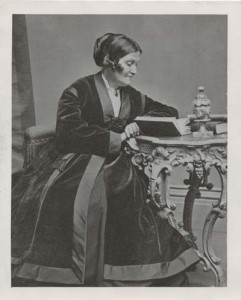 Born Circa 1810
Born Circa 1810
Birthplace Unknown
Died Circa 1899
Grave Site Unknown
Contribution Presided over the Adjourned Convention in Rochester, New York of the first Woman’s Rights Convention in 1848.
Quotation “It has seemed long in coming, but I think the time draws near when women will be acknowledged as equal with man.”
Abigail Norton was born about 1810. As a child she attended the First Presbyterian Church in Rochester, New York and later she became a member of the Second Presbyterian Church, or “Brick Church,” as it was known. While in her twenties, she also joined the Rochester Female Charitable Society (RFCS), an organization that had been formed in 1822 to care for the poor who were ill in Rochester.
In 1833, she married Henry Bush, an abolitionist who manufactured stoves for a living. The family struggled financially, and Abigail Bush became pregnant six times (two children died in infancy) between 1834 and 1846.
In the 1840s, Bush became active in the Western New York Anti-Slavery Society (WNYASS) formed in 1842. Although it is not known specifically if Bush was a participant, in addition to other anti-slavery activism the WNYASS women members were generally involved in a sewing circle and the organization of annual Anti-Slavery Fairs.
After the first Women’s Rights Convention was held in July 1848 in Seneca Falls, New York, those who attended agreed to hold an Adjourned Convention two weeks hence, in Rochester. They appointed an Arrangements Committee, consisting of Amy Post, Sarah D. Fish, Sarah C. Owen and Mary H. Hallowell, to plan for this meeting. The Arrangements Committee in turn had appointed a nominating committee (Amy Post, Rhoda DeGarmo and Sarah Fish), who decided to nominate Bush to preside at the convention in Rochester.
The action of nominating a woman and not a man caused quite a controversy during the Rochester convention, which began on August 2, 1848. Even such committed feminists as Elizabeth Cady Stanton and Lucretia Mott opposed Bush as President, believing that “it was a most hazardous experiment.” Bush later recalled that the opponents to her presidency stopped her in the hall on the way to the Convention. They tried to persuade her to join their forces and give up her attempt to preside. According to Bush, these forces stated they “had with them a fine-looking man to preside at all of their meetings, James Mott, who had presided at Seneca Falls.” Soon after, however, Bush met up with those who had nominated her, and “Amy Post, Rhoda de Garmo and Sarah Fish, …at once commenced labors with me to prove that the hour had come when a woman should preside.”
Post, De Garmo and Fish convinced Bush to proceed, and then led her into the Unitarian Church where the convention was to take place. Bush was elected to the post, but upon her “taking the chair,” Mott and Stanton “left the platform and took seats in the audience.” Bush went on to perform her duties through three sessions per day in the two-day meeting.
Bush stepped up to her position and by all accounts performed well. She stated that once she had proven herself, “Lucretia Mott came forward, folded me tenderly in her arms and thanked me for presiding.” However, Bush did seem to pay an emotional price for her success. She confided that, “When I found that my labors were finished, my strength seemed to leave me and I cried like a baby.” She ultimately concluded that the strain was worth it, because her action had “ended the feeling with women that they must have a man to preside at their meetings.”
Bush’s husband was supportive of her anti-slavery and women’s rights activities. However, shortly after the Rochester Women’s Rights Convention he decided to go to California to join the gold rush and to attempt to settle there. He left a pregnant Bush behind in Rochester. By the early 1850s, the whole family had settled in California, where Bush was to live for the rest of her life.
Bush’s advocacy of women’s rights continued when she moved to California. In 1878, she sent a congratulatory letter to the National Woman Suffrage Association (NWSA), which was at that time holding a convention in Rochester to celebrate the thirtieth anniversary of the first convention. She wrote, “Say to your convention my full heart is with them in all their deliberations and counsels, and I trust great good to women will come of their efforts.”
Twenty years later, at the National American Woman Suffrage Association (NAWSA) convention of 1898, Bush was lauded at a Pioneer’s Evening. Still living in California and now eighty-eight years old, Bush sent a letter to Susan B. Anthony on this occasion, in which she reminisced about her role in the 1848 Rochester convention. The letter states in part:
From that day to this, in all the walks of life, I have been faithful in asserting that there should be ‘no taxation without representation.’ It has seemed long in coming, but I think the time draws near when women will be acknowledged as equal with man. Heaven grant the day to dawn soon!
Bush, however, did not live to see women’s suffrage. She was to die shortly after writing her letter. The NAWSA convention of 1899 memorialized her as one of “those who had passed away,” and spoke “…of the splendid work” of Bush, one of the “early…pioneers.”
Bibliography of Suggested Books & Articles
- Barry, Kathleen, Susan B. Anthony: A Biography of a Singular Feminist, New York: New York University Press, 1988.
- Hewitt, Nancy A., Women’s Activism and Social Change, Rochester, New York, 1822-1872 Ithaca: Cornell University Press, 1984.
- History of Woman Suffrage, vols. I, III, IV, reprint, Source Book Press, 1970.